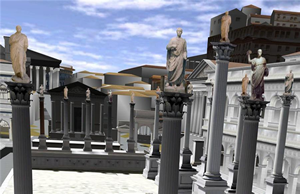RENCI is a multi-disciplinary collaboration between several universities in North Carolina, with centers located at the Europa Center, Duke University, N.C. State, UNC Chapel Hill, East Carolina University, UNC-Asheville, UNC-Charlotte, and the Health Sciences Library at UNC-Chapel Hill. Many of the centers focus on visualization and collaborative technologies, and have been involved in multi-touch "surface" computing.
The pictures below are from the RENCI center at Duke University:

Duke Multi-Touch Collaborative Wall
The multi-touch wall is 13 x 5 feet, and utilizes six high-definition projectors, resulting in a combined resolution of 5760-2160, and supports multiple users. According to information on the RENCI website, the design is scalable and applicable to non-flat surfaces. The wall system runs on Windows and Linux.

(Photo by Josh Coyle)

(Photo by Josh Coyle)
DI, or Direct Illumination is used for touch detection in both the wall and the table for detecting touch. A separate instance of Touchlib runs for each of the 8 cameras used to detect touch. A gesture engine interprets the information about touches on the screen as gesture events. Each camera is handled separately for image processing and blob tracking tasks.

Graphics from the RENCI Vis Group Multi-Touch Blog

Here is cool picture of the "Multi-touch Calibration Device", which uses a built-in TouchLib utility.

Additional information can be found on the RENCI Vis Group Multi-Touch Blog.
FYI
Touchlib is a multi-touch development kit that can be found on the NUI-Group website.
"Touchlib is a library for creating multi-touch interaction surfaces. It handles tracking blobs of infrared light, and sends your programs these multi-touch events, such as 'finger down', 'finger moved', and 'finger released'. It includes a configuration app and a few demos to get you started, and will interace with most types of webcams and video capture devices. It currently works only under Windows but efforts are being made to port it to other platforms."

If you are interested in creating your own multi-touch table, the NUI-Group website and forums are a great place to start.
Related:
If you follow my blog, you probably know that I've taken several graduate courses at UNC-Charlotte. Some of my professors and a classmate or two have been involved in some exciting visualization research over the past year. (If you are serious about multi-touch and other visually-based applications, it is worth taking some time to familiarize yourself with visualization and interaction research.)
News from the UNC-Charlotte Vis Center:
At the University of North Carolina at Charlotte, RENCI is a collaboration between the UNC Charlotte Urban Institute, the Center for Applied Geographic Information Science, and the Charlotte Visualization Center.
11/06/2008
Robert Kosara’s group wins two awards at IEEE VisWeek Caroline Ziemkiewicz and Robert Kosara won Honorable Mention (the second highest award) at the IEEE InfoVis Conference for their paper, “The Shaping of Information by Visual Metaphors”. Also, Alex Godwin, Kosara’s student, won Best Poster for his submission, “Visual Data Mining of Unevenly-Spaced Event Sequences”.

The Vis Center is pretty fascinating, as you can see by the group of visitors at an open house.
If you are just as fascinated by this stuff as the guys in the picture, here are links to some recent papers by UNC-Charlotte faculty affiliated with the Vis Center:
The Shaping of Information by Visual Metaphors (Caroline Ziemkiewicz and Robert Kosara)
Evaluating the Relationship Between User Interaction and Financial Visual Analysis (Don Hyun Jeong, Wenwen Dou, Felsia Stukes, William Ribarsky, Heather Richter Lipford, Remco Chang)
Visual Analytics for Complex Concepts Using a Human Cognition Model (Tera Marie Green, William Ribarsky, and Brian Fisher)
